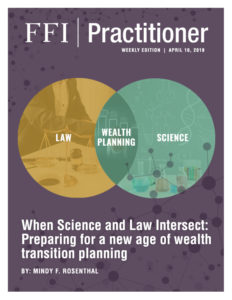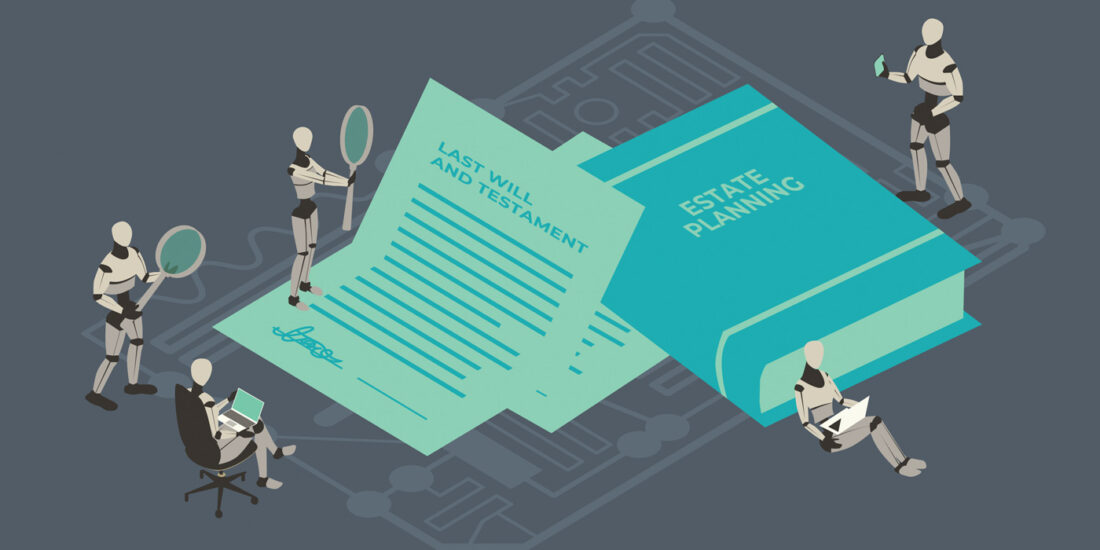
View this edition in our enhanced digital edition format with supporting visual insight and information.
This week’s FFI Practitioner examines how advances in science can impact multidisciplinary approaches to family business consulting and encourages professionals need to keep abreast of ongoing scientific developments as they relate to the family enterprise field Thanks to Mindy Rosenthal of the 2019-2020 FFI NYC Regional Planning Committee for contributing this article on advances in neuroscience and their impact on wealth planning.
It’s Edna’s 79th birthday, and the extended family has gathered to celebrate. The party is a lot more than cake and candles. Edna’s 59-year-old son Derick is grumbling in the corner to his 54-year-old sister Carol. “I should be running the family business by now. I don’t think mom is up to it. She’s so slow to make decisions, and I don’t think she understands things clearly anymore.” Carol notes mom has seemed distracted lately and that her friend’s mother was recently “tested” for Alzheimer’s Disease. They wonder out loud, perhaps we should try to have mom tested.
Advances in neuroscience that are being used to help predict and diagnose Alzheimer’s Disease (AD) may, in the not too distant future, be called upon when deciding some of the weightiest of legal decisions–impacting the control of family wealth. When science and law intersect, however, the cross roads are often filled with hidden potholes. Now is the time for professionals who focus on business succession and wealth transfer strategies to begin to explore the implications of integrating new advances in science into the legal landscape.
Advances in neuroscience have led to the discovery of various biomarkers of AD. It is important to know that the presence of a biomarker for AD does not, according to Dr. Lon Schneider, director of Alzheimer Research and the Clinical Center of California at the University of Southern California (USC), mean a person has or will get dementia from AD. Approximately 40 percent of people in their 70s have amyloid plaque but are not cognitively impaired and do not have pre-clinical Alzheimer’s disease, notes Dr. Schneider. Still it is likely that at some point in the future, tests for the presence of biomarkers for AD may impact competency assessments.
Competency assessments presently rely on subjective clinical diagnosis. Clinical experts are called upon to take a key role in predicting a person’s future cognitive and functional abilities based mainly on observed behavior. Professor Betsy J. Grey, the Jack E. Brown Professor of Law at the Sandra Day O’Connor College of Law at Arizona State University, sees a transformation coming in determining a person’s decision-making ability. “Law has always been influenced by advances in science and technology in determining legal responsibilities in various contexts. We can’t ignore these scientific advances and indeed should welcome them as they allow for more accurate diagnosis and prognosis of AD. Among other things, access to this information will allow individuals to more accurately plan for succession of wealth in an orderly fashion,” says Professor, who has written an extensive paper on considerations surrounding the use of biomarkers for AD in determining competency, Aging in the 21st Century: Using Neuroscience to Assess Competency in Guardianships.
There’s much to consider.
The science behind new tests for biomarkers is highly sophisticated, and interpretation of the data is by no means straightforward. The results are not a simple read of “positive”—you have, or will have, the disease—or “negative”—you don’t, or won’t, have it.
“Any test that could create a clear picture of someone’s competency or lack of competency would be very welcome,” says Warren Racusin, partner and chair of the Trusts and Estates Group at Lowenstein Sandler LLP. He notes he has worked on several situations where it needed to be determined if business succession planning was done with a person who had questionable competency. Racusin cautions, “Given the current state of the art, you need to be very careful. Tests can be misused.”
Questions to consider cover three areas:
- Whether judges, lawyers and, when applicable, jurors have the ability to understand the science behind the tests. In our example above, would they be able to understand the neuroscience behind a positive test for an AD biomarker? “The idea that a judge could order a biomarker test, or evaluate an expert based on whether the expert ordered a biomarker test (did the judge go to med school?), that could be a mess,” Dr. Schneider says.
- When should a test be used? Professor Grey, in her paper, delves into how advances in neuroscience will and should affect the legal and clinical aspects of competency assessment in guardianship determinations. She asks:
- Should a brain state, independent of observable behavioral changes, even be considered in competency assessment, or should biomarker evidence only be incorporated into a traditional clinical diagnosis, after behavioral symptoms manifest, or used for a prognosis determination?
- Since changes to brain states, as documented by biomarkers represent a continuum, rather than distinct stages, what weight should biomarker evidence be given?
- How do we protect against the dangers of bias and over-diagnosis?
- How to ensure financial exploitation and elder abuse do not result from the fact a test could be used?
Living longer.
People are living longer, and wealthier people tend to outlive those with fewer resources. A 60-year-old man in the US can now expect to live to age 81, a full five more years than in 1970.1 The life expectancy gap between those in the highest quintile of income and the lowest quintile is 12.7 years.2
A longer life does not necessarily translate to health, happiness, and family harmony.
On the darker side of multi-generational wealth, restless heirs in waiting may seek out means to wrest control of the family fortune.
Both Professor Grey and Dr. Schneider see possible misuses of biomarker data constituting elder abuse and financial exploitation even if it is not admissible as part of a competency examination. “…We can’t ignore the risks involved and need to guard against the potential of undue pressure and exploitation from family members when these earlier brain states are identified,” says Professor Grey.
- Would members of a family-run business take advantage of the biomarker findings to pressure the individual to turn to surrogate decision-making?
- Would family members press an individual not to contest guardianship proceedings after brain alterations are identified or a genetic predisposition found, but while the individual still thinks he is competent?
- Would heirs use the presence of biomarkers as additional evidence that their parent did not have all their facilities when drafting their wealth transfer plans if they do not leave them their expected inheritance?
On the sadder side of aging, over 7 ½ million people will suffer from dementia from Alzheimer’s disease in the next decade.3 Some of those will include matriarchs and patriarchs still at the helm of their family businesses and responsible for the family wealth. Professor Grey questions if the lack of AD biomarkers in a respondent could make the showing of incapacity harder to demonstrate.
Advances in neuroscience may in time impact legal decisions surrounding competency. Now is the time to start learning more about what the science does and does not mean. And to explore how tests for biomarkers for AD might supplement or impact present clinical approaches to determining competency. As Racusin sums up, “My gut reaction is we should be educating ourselves more than we are—on how tests for biomarkers are used and who uses them. We need to do a better job to understand the range of scientific technology today and its flaws and limitations.”
References
1Life Tables for the United States Social Security, Actuarial Study No. 120, Available at: https://www.ssa.gov/OACT/NOTES/as120/LifeTables_Tbl_10.html
2Research Paper No. 2007-01, “Mortality and Lifetime Income Evidence from Social Security Records,” (Duggan, Gillingham, Greenlees), Available at: https://www.treasury.gov/resourcecenter/economic-policy/Documents/rp2007-01.pdf
31. PATRICIA A. TABLOSKI, GERONTOLOGICAL NURSING REVIEW AND RESOURCE MANUAL 11 (Am. Nursing Credentialing Ctr. ed., 3d ed. 2012). See also Alzheimer’s Ass’n, 2016 Alzheimer’s Disease Facts and Figures, 12 ALZHEIMER’S & DEMENTIA 459, 471 (2016), https://www.alzheimersanddementia.com/article/S15525260(16)00085-6/pdf [https://perma.cc/7MQV-2QVR].
About the Contributors
 Mindy F. Rosenthal is a senior content and engagement strategist specializing in bridging the wealth management goals and challenges of high-net-worth families to actionable solutions. A valued writer, journalist, and speaker, she provides wide-ranging educational thought leadership across multiple platforms. Most recently Mindy was national managing director of the PNC Center for Financial Insight. Prior to joining PNC, she served as managing director, N.A. of Campden Wealth, responsible for building Campden’s North American division. Mindy can be reached at [email protected].
Mindy F. Rosenthal is a senior content and engagement strategist specializing in bridging the wealth management goals and challenges of high-net-worth families to actionable solutions. A valued writer, journalist, and speaker, she provides wide-ranging educational thought leadership across multiple platforms. Most recently Mindy was national managing director of the PNC Center for Financial Insight. Prior to joining PNC, she served as managing director, N.A. of Campden Wealth, responsible for building Campden’s North American division. Mindy can be reached at [email protected].
About the 2019-2020 FFI Regional Planning Committee
The purpose of this committee is to expand the presence of FFI as an organization and the FFI members themselves in the NYC area in the next two years, to build enthusiasm for the 2020 October conference, and to promote the multidisciplinary, global approach that is at the core of FFI’s mission “to be the most influential global network of thought leaders in the family enterprise field.” This article represents the first in a series of pieces from the committee.

View this edition in our enhanced digital edition format with supporting visual insight and information.





